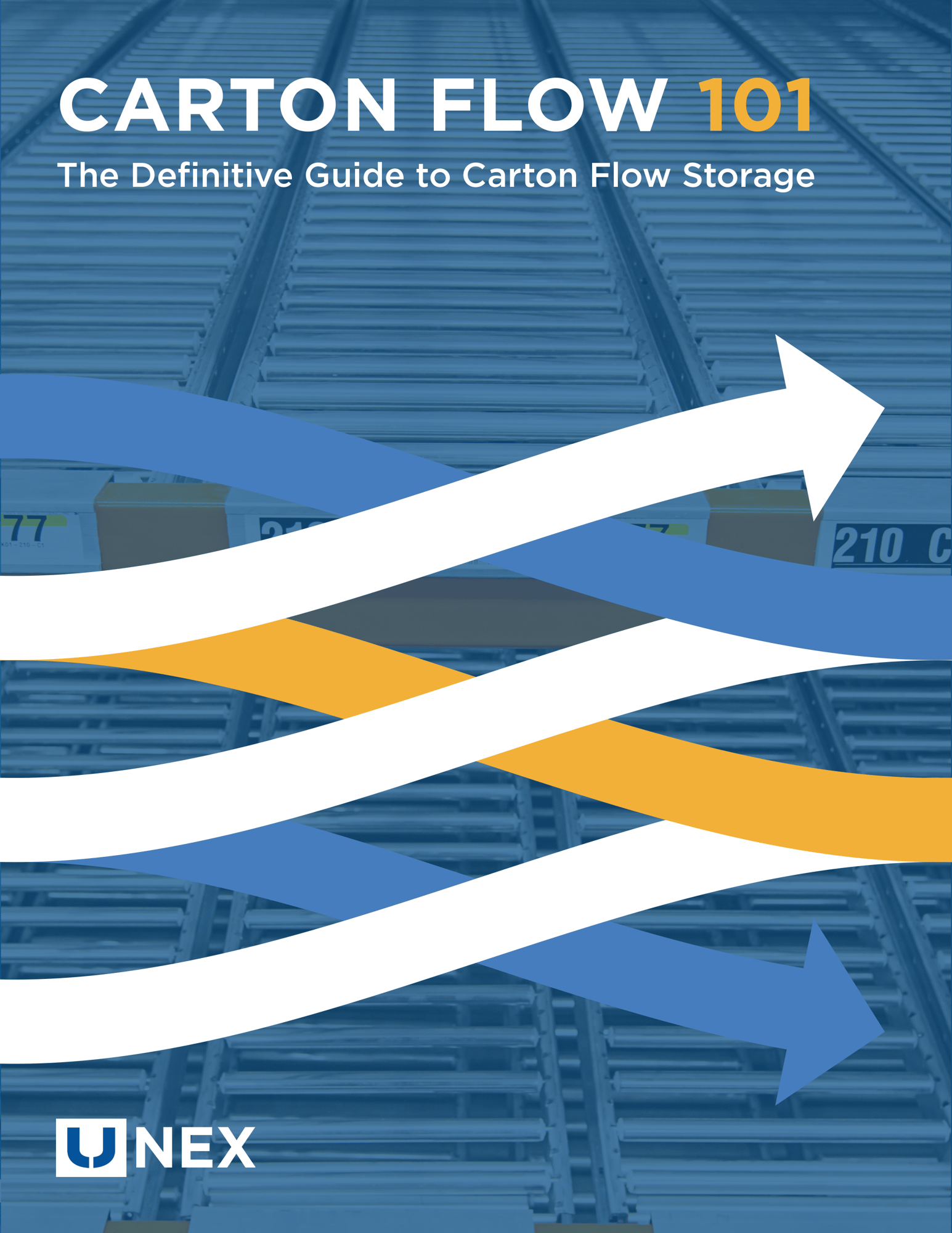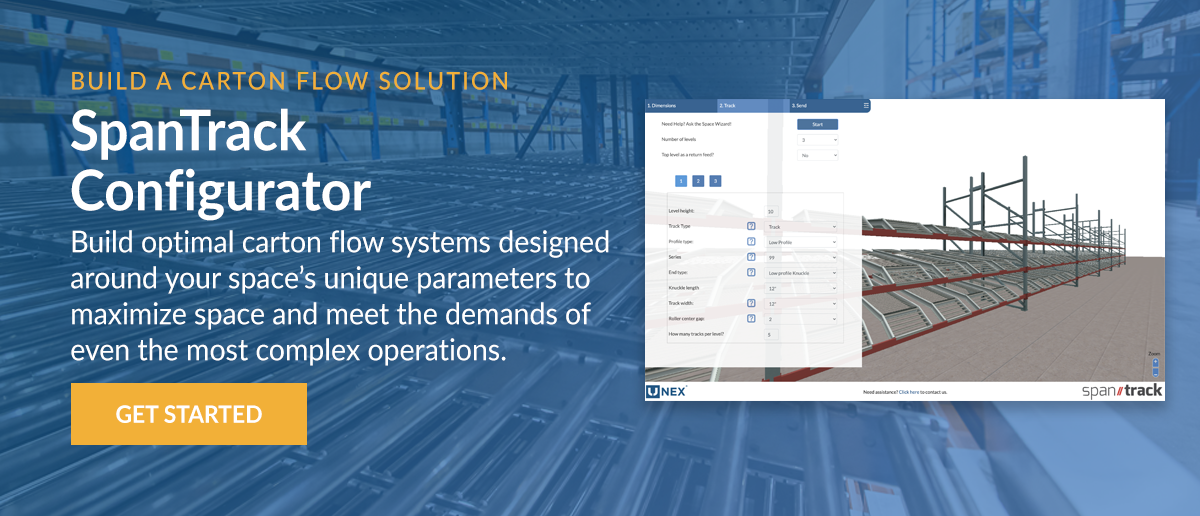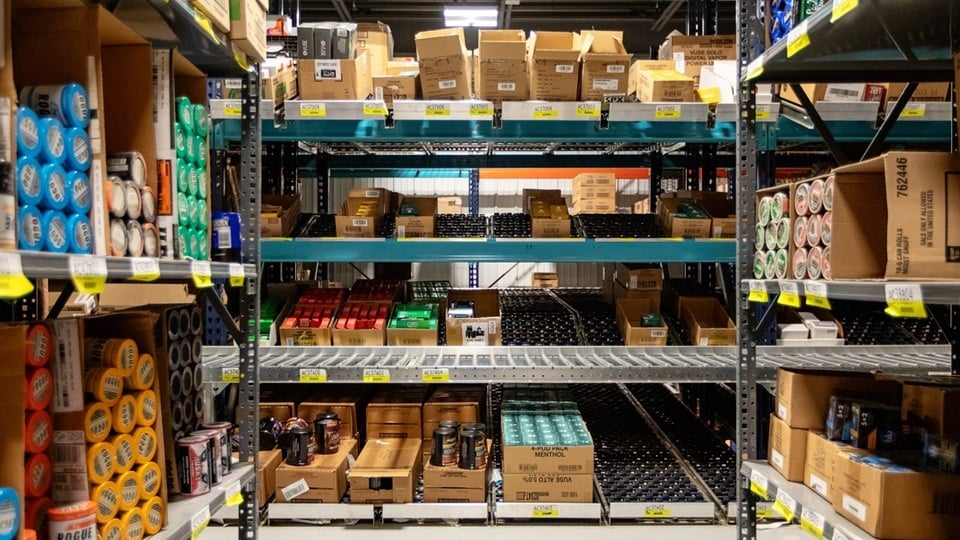How to Improve Warehouse Efficiency with Carton Flow Racking Systems

In the world of eCommerce, fulfillment isn’t slowing down anytime soon — at least not for companies that want to keep up with customer demand. According to a recent Forrester report commissioned by Amazon, customers now expect an average click-to-delivery speed of 2.5 days, compared to 5.7 days just five years ago. In another five years, it’s expected to be 1.5 days.
Such a rapid pace of change puts extraordinary pressure on warehouses and delivery centers to streamline their inventory management and fulfillment processes. While there are many ways to go about making these improvements, few offer as effective or straightforward a solution as carton flow rack systems.
Through simple reliance on gravity, carton flow racks facilitate improved inventory flow for enhanced warehouse efficiency. Here’s an overview of how they work, a few common types, and the best practices for implementing carton flow storage for your warehouse.

Understanding Carton Flow Racking Systems
All carton flow racks are built on the same basic principle: They use angled shelves to move inventory from the back of the shelf to the pick face. This facilitates first-in, first-out (FIFO) inventory management, allowing stockers to replenish new inventory from the back, while pickers remove old inventory from the front.
Outside this basic setup, carton flow rack systems use a variety of components to enhance inventory management and order fulfillment. While some come with outdated plastic wheel rails, more effective solutions leverage smoother skate-wheel beds or roller lanes to support inventory movement. Some can even be tailored to warehouse needs with knuckled end treatments, lane guides, and other accessories that allow for better product organization and easier access.
Choosing the best carton flow rack system for your warehouse comes down to several key factors, including your SKU mix, product size and weight, order volume, and ideal shelf layout. In many cases, warehouse managers find it best to mix a variety of dynamic storage solutions with other solutions like static shelving and various forms of automation.
Related Reading: How to Design Your Own Carton Flow Storage System Based on Footprint
Direct Benefits of Carton Flow Racking Systems
Implementing carton flow can provide a host of advantages to support warehouse operations:
- Increased efficiency: As a dynamic storage solution, carton flow puts more products at the pick face, reducing the need for workers to hunt for products or travel farther to find them. Implementing carton flow systems can reduce warehouse pick paths by as much as 65%, bringing an immediate efficiency boost.
- Space optimization: Because inventory can be better organized from front to back, carton flow shelves require less shelf space for the same amount of product storage. Greater SKU density can help you avoid premature warehouse expansion and keep your footprint as small as possible.
- Improved ergonomics: The Occupational Safety and Health Administration reports that poor workplace ergonomics account for as much as 60% of worker injuries. In warehouses, inefficiently organized shelves often require workers to reach and strain for products, exposing them to unnecessary risk of injury and fatigue. Carton flow provides a simple remedy for these dangers to employee health and morale.
- Enhanced inventory management: Carton flow systems support proper inventory sequencing for FIFO inventory management, which is designed to ensure product quality and reduce waste. This drives customer satisfaction and boosts profit margins.
Get The Definitive Guide to Carton Flow Storage and The Ultimate Order Picking Checklist. Download the guide today!

Implementing Carton Flow Systems to Enhance Warehouse Efficiency
Like other dynamic storage solutions, carton flow systems are designed to improve storage and order picking efficiency in the warehouse. However, careful planning is critical to ensure you make the most of these benefits.
To properly utilize carton flow in your warehouse, take the following four steps.
1. Conduct a Comprehensive Needs Analysis
Any significant change to warehouse layout or systems must begin with a thorough understanding of what you’re trying to accomplish. With many options for carton flow shelving, racks, and end treatments, it’s essential to have a clear picture of the problem areas in your workflow.
Where are the bottlenecks? What products require excessive travel during fulfillment? Where are you relying too heavily on forklifts? How could shelf space be consolidated with a better inventory flow? Assess these and any other inventory management challenges before choosing any new shelving.
2. Design the Optimal Layout
Each warehouse has unique layout needs — there’s no one-size-fits-all floor plan for efficient carton flow. Consider a few key factors to help you determine the best way to integrate dynamic shelving into your warehouse:
- Loading dock location: Placing carton flow shelves too far from the loading dock will introduce unnecessary travel to the stocking and fulfillment processes.
- Existing pallet racking: Evaluate current rack supports and placement to see where you can integrate carton flow into existing racks or swap static shelving for dynamic carton flow racks, leveraging your existing layout with improved inventory movement.
- Floor-to-ceiling needs: Consider how to integrate carton flow shelves underneath pallet storage to make the most of your existing footprint.
- Integration with other warehouse technologies: At their best, carton flow systems are made to integrate with other enhancements in inventory management. When planning, it’s smart to consider how you’ll pair new shelving with conveyors, pick-to-light systems, or other modern warehouse technologies.
3. Customize for Specific Needs
As noted, SKU mix plays a big role in determining the ideal inventory layout and shelving setup. For instance, products with uniform sizing may benefit from fixed lane sizes, while wheel beds provide more flexibility with adjustable lanes. Likewise, knuckled end treatments are best for each picking situations, while hangerless racks keep beam fronts clear to minimize product intrusion into the aisles.
As you plan new warehouse storage solutions, look beyond your immediate needs toward future growth and layout changes. Modular flow rack systems like UNEX SpanTrack Lane and SpanTrack Wheel Bed, which we’ll explore further below, are built with flexibility in mind so you can adjust shelf layout and design as your inventory needs shift.
4. Weigh Different Implementation Strategies
Choosing between a gradual implementation and a full-scale carton flow rollout is another key aspect of the planning process. A phased rollout spreads equipment expenses over time and allows staff a long period to learn new systems, while a full-scale implementation may bring more immediate benefits in terms of operational efficiency.
Whichever way you choose, be sure to plan for extensive staff training and preparation. Before new shelves even arrive, you have a chance to “sell” the benefits to your team and secure buy-in. Then, once shelves are in place, training stockers and pickers on proper protocol and workflow will ensure you get the most out of your carton flow system.
UNEX Carton Flow Solutions for Warehouse
There’s a lot to consider when exploring carton flow rack systems for your warehouse. The good news is that UNEX offers straightforward solutions that can be engineered to fit your needs and maximize efficiency for your operation. Our carton flow systems — SpanTrack Lane and SpanTrack Wheel Bed — offer maximum flexibility and superior FIFO inventory management, whatever your needs.
SpanTrack Lane
 SpanTrack Lane carton flow rollers are our original carton flow solution. These storage lanes are well suited to each picking and case picking applications, offering clean, organized lanes for consistent, reliable product flow.
SpanTrack Lane carton flow rollers are our original carton flow solution. These storage lanes are well suited to each picking and case picking applications, offering clean, organized lanes for consistent, reliable product flow.
SpanTrack Lane is also well suited for warehouses with oddly shaped products or packages with uneven bottoms. Stainless steel rollers provide over 300% more product contact than plastic wheel rails, facilitating a smooth and seamless inventory flow.
These features proved perfect for Atlas Distributing, a beverage distributor in New England. When the company prepared to accommodate the addition of a major beer brand, SpanTrack Lane allowed Atlas to make room for 10 times as many beer cases without expanding its footprint.
SpanTrack Wheel Bed
 SpanTrack Wheel Bed utilizes skate wheels with a hex-hub design to create optimal flow. Like SpanTrack Lane, these wheel beds drop right into existing pallet racks for easy installation. But SpanTrack Wheel Bed is made for warehouses with a wide range of SKU types, sizes, and weights, along with those that face frequent inventory changes.
SpanTrack Wheel Bed utilizes skate wheels with a hex-hub design to create optimal flow. Like SpanTrack Lane, these wheel beds drop right into existing pallet racks for easy installation. But SpanTrack Wheel Bed is made for warehouses with a wide range of SKU types, sizes, and weights, along with those that face frequent inventory changes.
Carton flow beds are the ideal choice for businesses that need to maximize flexibility and accelerate inventory flow. Shark fin infeed guides allow you to change lane width to accommodate new inventory at any time, while the patented, durable hex-hub wheels create the smoothest possible flow. Cutter & Buck, a Canadian active apparel brand, saw pick rates increase by 150% after installing wheel beds in its warehouse.
Next Steps for Improving Your Warehouse Efficiency
Warehouse efficiency has never been a more critical consideration for managers and operators. Across a wide range of industries, the need to accelerate fulfillment and streamline the flow of inventory in and out of the warehouse has taken center stage.
Carton flow rack systems play a pivotal role in these high-demand warehouse environments. With the right racking solutions and effective planning, warehouses can maximize the use of floor space, simplify FIFO stocking and fulfillment processes, and get products to customers faster than ever.
UNEX carton flow racks are uniquely designed to fit the needs of modern warehouses. Whether you need to ensure maximum flexibility or a frictionless inventory flow, our specialists can help you choose the ideal setup for your situation. Contact us today to set up a free consultation.


